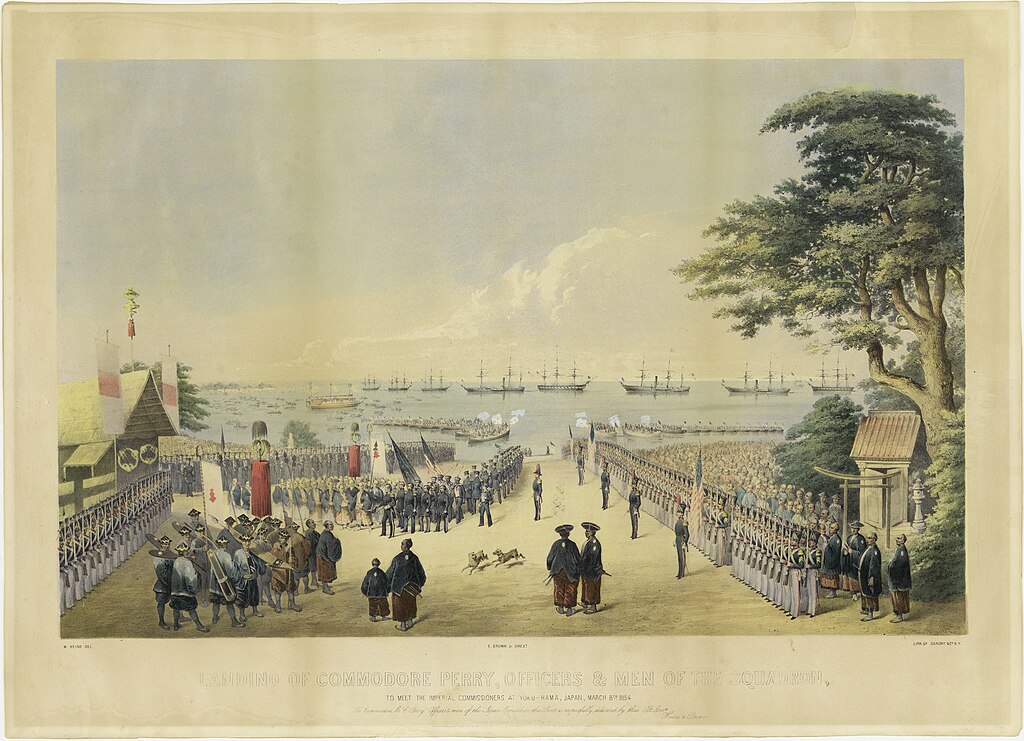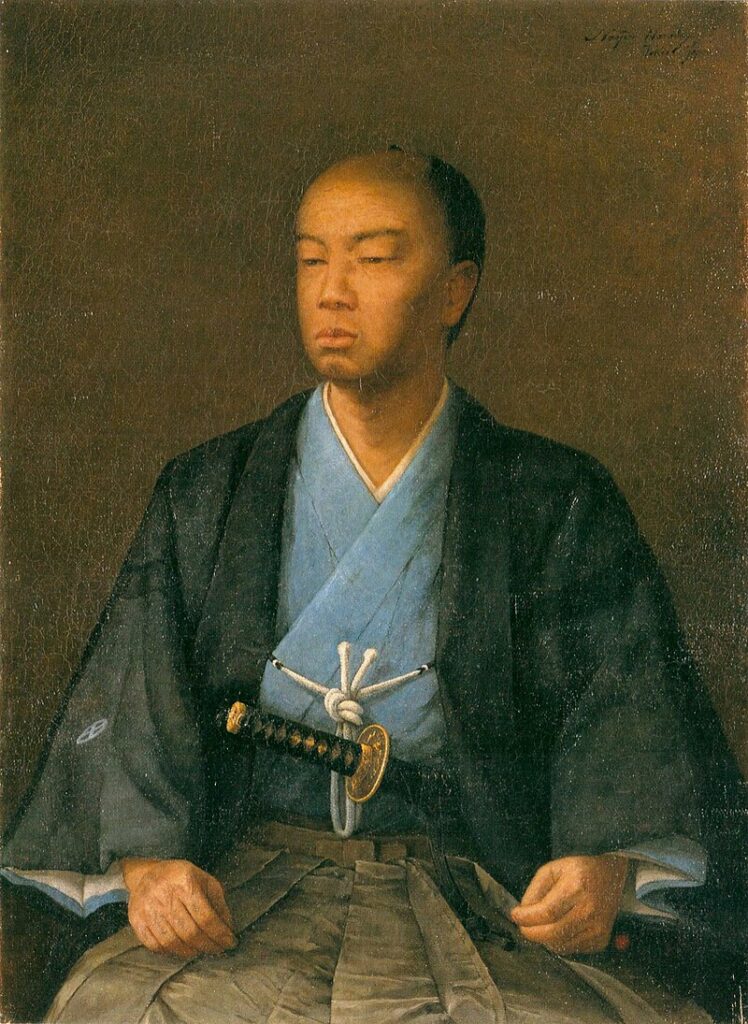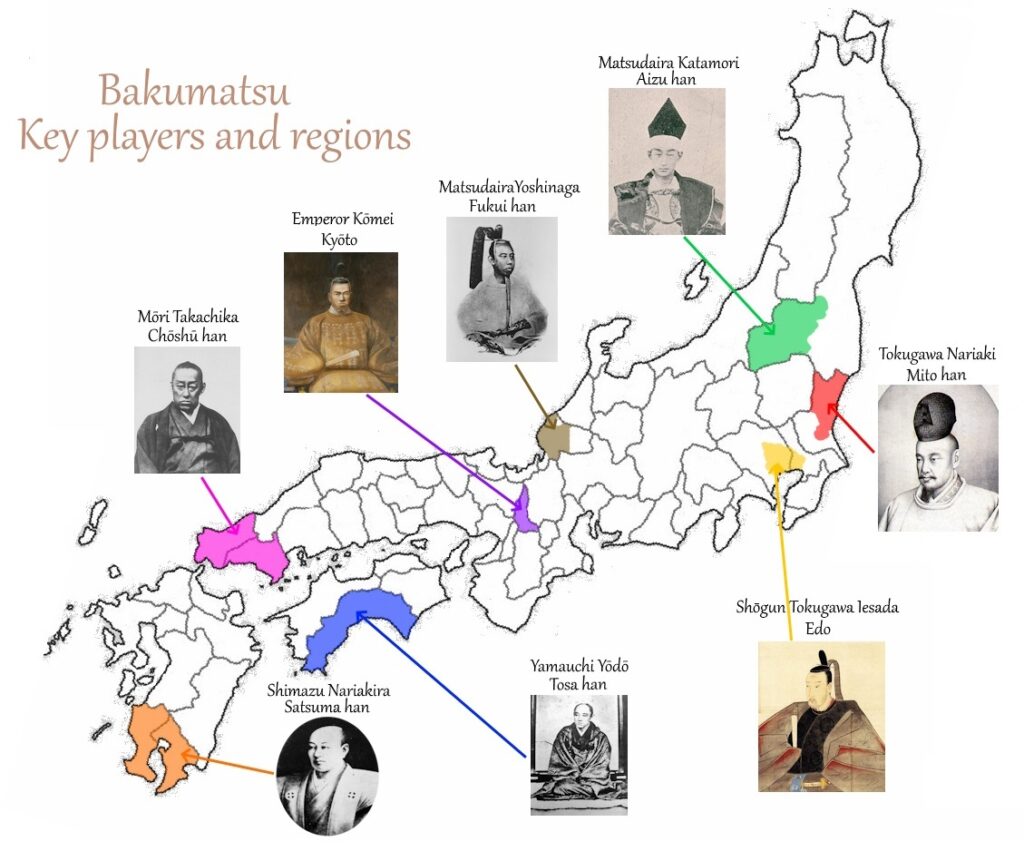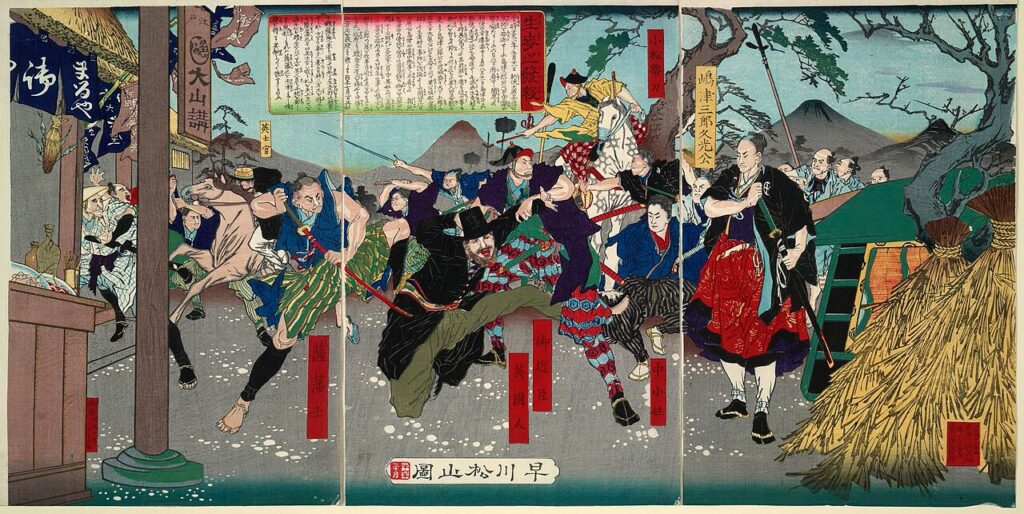Bakumatsu – the end of the shōgunate Pt. 1
Bakumatsu… The end of the Edo shōgunate… No shōgunate goes down without a fight! The Kamakura shōgunate ended with a two-year war orchestrated by Emperor Go-Daigo. The Muromachi shōgunate slowly faded out as the Sengoku daimyō rose to power until it was eventually finished off by Oda Nobunaga. The end of the Edo shōgunate, however, was significantly more complicated. It involved a series of political and military battles between the shōgunate, certain han who had recently amassed small fortunes in wealth and the might of foreign naval powers.
Next to Sengoku, Bakumatsu ranks second in Japanese people’s favourite periods in history. To put into perspective just how complicated a time it was, whereas I was able to sum up the first 250 years of the Edo era in around 7,000 words, this―the final 15 years of the Edo era―has taken me over 9,000! Let’s not waste any more of them on the introduction, though. We have a lot to get through. And it all begins with the arrival of a power the shōgunate could never have predicted: the USA
Note: all years and dates in this article correspond to those of the lunar calendar, which was in use in Japan at the time
The arrival of the black ships

In 1853, Commodore Matthew Perry led four ships into the bay of Uraga with orders from President Fillmore to force a trade agreement with Japan. Under normal circumstances, he would have been turned away(as was the case with a handful of other American and Russian naval officers who had ventured into the port several years earlier). However, by 1853, the shōgunate had been weakened by a number of bad decisions made in response to both the impending foreign threat and a famine that had left over one million people dead.
Those decisions led to a major loss in support, which resulted in a rebellion at the hands of a local administrator in Ōsaka, whose men burned down one-fifth of the city. Matthew Perry’s timing was spot on. Being accompanied by four intimidatingly large black ships was the deciding factor. He met briefly with Abe Masahiro, head of the rōjū, stating menacingly that he would be back the following year to finalise an agreement.
The major players of the time

Accomplished as he was in his position, Masahiro had never faced a problem of this level of complexity or magnitude. In fact, no rōjū ever had! And so he turned not only to his advisors but to any daimyō of any status in search of advice. This afforded three semi-influential men a foot in the door of the shōgunate: Tokugawa Nariaki, Matsudaira Yoshinaga, and Shimazu Nariakira. As his name suggests, the first man on that list was a distant relative of the shōgun. Head of the Mito branch of the Tokugawa family, Nariaki was stationed permanently in Edo, which allowed him to obtain information regarding the shōgunate earlier than most other daimyō in the country. Yoshinaga too was a distant relative of the Tokugawa family. Head of the Echizen han, his ingenuity and financial expertise had made his domain one of the most prosperous in the country.
Satsuma han
It’s the third person on this list who we’re going to be focusing on, though: Shimazu Nariakira, 28th head of the Shimazu household and 11th head of Satsuma han. All the way back at the start of the Edo era, after finding themselves on the losing side of Sekigahara, the Shimazu had been forced to keep their head down in an effort to avoid losing their territory. Had it not been for the fact they had such strong ties to the string of islands known as Ryūkyū to the south of Japan, they would most likely have been forced to disband. For this reason, it’s unlikely that any head of the Shimazu family throughout the Edo era had held any significant level of respect for the Tokugawa shōgunate.
Towards the middle of the 19th century, however, the tide was beginning to change in Satsuma. A chief retainer by the name of Zusho Hirosato implemented an economic reform that took the impoverished domain out of the red. By importing products from Qing to sell throughout the domain, trading sugar obtained from Ryūkyū and threatening local merchants into agreeing to allow the Shimazu to pay back their debts interest-free over the course of the following 250 years, Hirosato took Satsuma from five million ryō worth of debt to a surplus of two million! It was this reform which earned Hirosato’s master, Shimazu Nariakira, an invitation to the shōgunate.
The Treaty of Peace and Amity
Despite the establishment of his A-team, however, one year later when Perry returned with nine black ships, Masahiro still hadn’t been able to find any alternative to agreeing to the treaty with the USA. And so, after 250 years of having been closed to the outside world, Japan opened its gates, allowing American vessels entry to two of its ports: Hakodate and Shimoda. To make matters worse, Perry forced Japan to include a one-sided ‘Most Favoured Nation Clause’, ensuring that if Japan were to form a more attractive agreement with another nation, they would have to update the terms of their agreement with the USA to award them the same conditions. Despite having had little choice, Masahiro took a lot of flak for his decision. His death three years later at the age of 37 is attributed to the overwhelming amount of stress that was likely caused by this situation.


In 1856, an American named Townsend Harris helped to establish the first US consulate in Japan and became the first Consul General. His first job was to put pressure on Japan to sign a formal trade agreement with the USA. The treaty formed two years earlier only gave American vessels the right to dock in two of the country’s ports. The president was looking not only for access to a greater number of ports but also to open a door to the east that would allow the US to gain a vast amount of profit through trade. The shōgunate began to sweat once more. They knew by now that they were powerless to stop the course on which they had set the country. On the other hand, though, many still opposed their decision to give in to the demands of foreign powers, not least of whom, the emperor.
Ii Naosuke
Emperor Kōmei was renowned for his dislike of foreigners. However, signing the agreement could not be achieved without his consent. As none of the rōjū were qualified to take on such a treacherous role, in 1858, Ii Naosuke, head of Hikone han, was brought in to assume the position of Tairō―a role that surpassed the status of rōjū and which was only granted in the most desperate of times. This effectively gave Naosuke unrivalled power over every man in the shōgunate.

Before assuming the position, Naosuke had already made up his mind to sign the agreement and open the country. Having heard stories of the foreign powers, he knew all too well that Japan had no hope of opposing their will. And so he sent a number of his top men down to Kyōto to convince the emperor. Naturally, this didn’t end well; they were sent right back to Edo with their tails between their legs. Left with no other choice, Naosuke signed the agreement without the consent of the emperor, knowing full well the implications of this action―chiefly that it signalled to the people that the shōgunate considered itself higher than the court and only intended to carry out the wishes of the emperor as long as those wishes were in line with their own.
Naosuke agreed to open four new ports: Kōbe, Nagasaki, Nīgata, and Yokohama. Additionally, having suffered an overwhelming amount of pressure from Harris, he agreed to an extraterritoriality clause, allowing American citizens who committed crimes on Japanese soil to be tried under American law; and tariff autonomy, giving America the right to set the tariffs on all items imported to and exported from Japan. After forming this agreement, Naosuke went on to sign similar agreements with Britain, France, Russia and Holland.
The consequences of the trade agreements
Within a year of signing these trade agreements, Japan was flooded with cholera, brought over by foreign merchants staying in the various ports accessible throughout the country. Foreign trade also had a negative impact on Japan’s economy; the import of cheap cotton fabrics was a huge blow to the country’s textile industry. In addition, as silk thread fetched a higher price overseas, farmers began selling directly to foreign merchants rather than going through Edo, putting wholesalers out of business and bringing about inflation as people scrambled to get their hands on the little thread and dwindling number of various other items that were left in the country. In order to combat this, the shōgunate decreed that silk thread, grains, oil, wax, and cloth could only be sold through Edo. This infuriated foreign merchants, who ignored the law and continued to obtain these items through secret deals with local merchants.
Succession dispute
For these reasons and more, Ii Naosuke became extremely unpopular with Japanese merchants as well as the general population. Next, he would become similarly unpopular with the daimyō. Shortly after signing the deal with the USA, Naosuke was presented with the perfect opportunity: the death of the shōgun. Tokugawa Iesada died without producing an heir, leaving the shōgunate pondering over his successor. Naosuke supported Iesada’s cousin, Tokugawa Yoshitomi. At just 12 years of age, he would make the perfect puppet, allowing Naosuke continued authority over the shōgunate. Tokugawa Nariaki, Matsudaira Yoshinaga, Shimazu Nariakira and Yamauchi Yōdō―head of Tosa han―supported Nariaki’s son, 21-year-old Tokugawa Yoshinobu. Young, smart and educated, he was perhaps the perfect candidate. Therefore, it stood to reason that Naosuke would have to do everything in his power to ensure that Yoshinobu did not step foot within the doors of Edo Castle.


The Ansei purge
Naosuke wasn’t fazed by his opposition, however; had he been the sort of man who curled himself up in a blanket and rocked himself to sleep at the first sign of adversity, he never would have been chosen for the role of Tairō. He continued swatting away every fly that flew into his face, confident that in the end he would have his way. However, when the emperor sent a secret correspondence to Tokugawa Nariaki asking for Mito han’s help in repealing the agreements Naosuke had made and chasing all foreigners out of the country, Naosuke could no longer keep his cool. In fact, he snapped. Not only did he install Yoshitomi as the 14th shōgun despite the enormous opposition of the daimyō, but he went so far as to kill, imprison and force into retirement anyone who expressed any level of discontent towards his actions.

Over the course of the following two years, he sentenced 14 people to death, including a legendary teacher from Chōshū han by the name of Yoshida Shōin(although admittedly, Shōin did kind of deserve it; he confessed a plan he had devised to kill Naosuke’s right-hand man). He put Yoshinobu, Yōdō and Yoshinaga under house arrest and forced Nariaki into retirement. Shimazu Nariakira gathered 5,000 men and planned to march them to Edo to put a stop to Naosuke’s tyranny, but he died right before his departure. Had this not been the case, in all likelihood he too would have been made to face one of these punishments.
The Sakuradamon Incident
If Game of Thrones taught us anything, madness of this degree doesn’t go long unpunished. In March of 1860, 17 samurai from Mito and one from Satsuma joined forces to kill Naosuke as he made his way towards Edo Castle’s Sakuradamon gate. Not only did this succeed in ending Naosuke’s dictatorship, but it also proved that the shōgunate was powerless to stop the wave of discontent that had spread among the general samurai populace. Just months after Naosuke’s murder, Tokugawa Nariaki died. The timing was so perfect that it was rumoured he’d been poisoned by Hikone han in an act of revenge.
Shimazu Hisamitsu

In an effort to solidify the country and quell the growing discontent, the shōgunate decided to join forces with the court in 1862. In order to achieve this, the court arranged for the emperor’s younger sister, Kazunomiya, to marry the shōgun, who had now changed his name to Tokugawa Iemochi. Elsewhere, Shimazu Hisamitsu, who had assumed control of Satsuma after his brother, Nariakira’s, death, also decided to create ties with the court and have the emperor grant him permission to negotiate with the shōgunate on the court’s behalf. Under normal circumstances, the shōgunate would never have allowed a daimyō of such low status as Hisamitsu’s anywhere near the court. As I mentioned earlier, though, they were now powerless to stop this kind of activity.
Hisamitsu perhaps miscommunicated his intentions to his people, however, as a number of them believed they were heading to the capital to drive the foreigners out. Among those was a small band of men led by Arima Shinshichi, who arrived in the capital ahead of Hisamitsu and began to formulate a plan to kill the kanpaku and the Kyōto shoshidai. Upon hearing word of this plan, Hisamitsu sent his men to deal with the problem. Arima’s men were found in a small inn by the name of Terada, where they faced the full wrath of the Satsuma army. As luck would have it for Hisamitsu, though, his swift and efficient resolution of the problem gained him further trust within the court and convinced the emperor to award him the authority he had come in search of. With improved status, Hisamitsu marched his men on to Edo.
The Bunkyū Reform
Once in Edo, Hisamitsu set about levying his relationship with the court to negotiate a reform with the shōgunate. The result was an ease in the conditions surrounding sankin-kōtai―a costly duty imposed on all daimyō whereby they were obliged to spend every second year in Edo. After the reform, the conditions were relaxed to 100 days every three years. Needless to say, this change was hugely popular with daimyō families all over the country. It didn’t stop there though; Hisamitsu also convinced the shōgunate to allow the wives and children of daimyō forced to live permanently in Edo to return to their home provinces. Originally, this system had been devised as a measure to dissuade rebellion among the more powerful daimyō. However, with the shōgunate weakened, rebellion had become increasingly likely. It was now in the shōgunate’s interest to sweeten the deal for potential enemies.
Elsewhere, Hisamitsu had his friends installed in strategic positions around the country. Tokugawa Yoshinobu was named guardian to the shōgun. Matsudaira Yoshinaga was awarded a position that put him in charge of supervising all internal and external political issues dealt with by the shōgunate. Matsudaira Katamori, head of Aizu han, was granted a newly-devised position that gave him undisputed command over Kyōto, surpassing even the authority of the shoshidai.
The Namamugi Incident
Hisamitsu was set to usurp the shōgunate’s power and lead Satsuma to the position of top han in the country. However, on the way back to Satsuma, he stepped on a giant Britain-shaped landmine. While passing through a small town south of Edo known as Namamugi, his procession found itself faced with four English tourists on horseback. It was common knowledge in Japan that when encountering a daimyō procession, it was courtesy to step to the side of the road and bow your head towards the ground until the procession passed. Unfortunately for the unwitting foreigners, the shōgunate’s tourist association had failed to make this etiquette clear to its new inbound guests.
Neither party being able to understand the other’s words, Hisamitsu’s men hastily signalled for the group to clear the road. Charles Richardson, the group’s leader, mistook this for a command to pass by the side of the road. Once he realised the road was too narrow for this, he tried to turn back, only to end up leading his horse into the middle of the procession.
Naturally, the Satsuma army’s priority was the protection of its commander. Left with little choice, the closest soldier drew his sword and struck Richardson, leaving him with a near-fatal wound. The panicked Englishman fled as two of his friends were attacked. He made it half a mile before falling from his horse. Satsuma’s soldiers chased him down and finished him off. The rest of his party escaped to the American consulate, where, despite their extreme panic, they managed to explain the situation. Britain demanded £100,000 from the shōgunate in compensation(roughly $200,000,000 in modern money), and £2,500 from Satsuma, in addition to the execution of Richardson’s killer. The shōgunate quickly paid their share, but Satsuma ignored both of Britain’s demands.
Growing wave of rebellion
Elsewhere, discontent towards both the shōgunate and foreigners was reaching new heights. Mito han attempted to repeat the stunt they had pulled on Ii Naosuke by attempting to assassinate the shōgunate’s new top dog, Andō Nobumasa. Although their plan failed, they did succeed in landing a strike to Nobumasa’s back. This was taken as evidence that Nobumasa had turned his back to his enemy, suggesting that he had tried to escape. This was viewed as an act of cowardice among the samurai community. As a result, he was made to step down several months later.
Yoshida Shōin’s pupils decided to continue to carry out their sensei’s will by burning down the British embassy. Among the small group were Takasugi Shinsaku and Kusaka Gensui―Shōin’s two star pupils―as well as Itō Hirobumi, who(spoiler alert)would later go on to become Japan’s first prime minister.
With the game set up and the players beginning to make their moves, it’s time to take a break. Satsuma han’s taken a clear lead in this first part. Join me in part two to find out who the other players are and how they affect this epic story.





